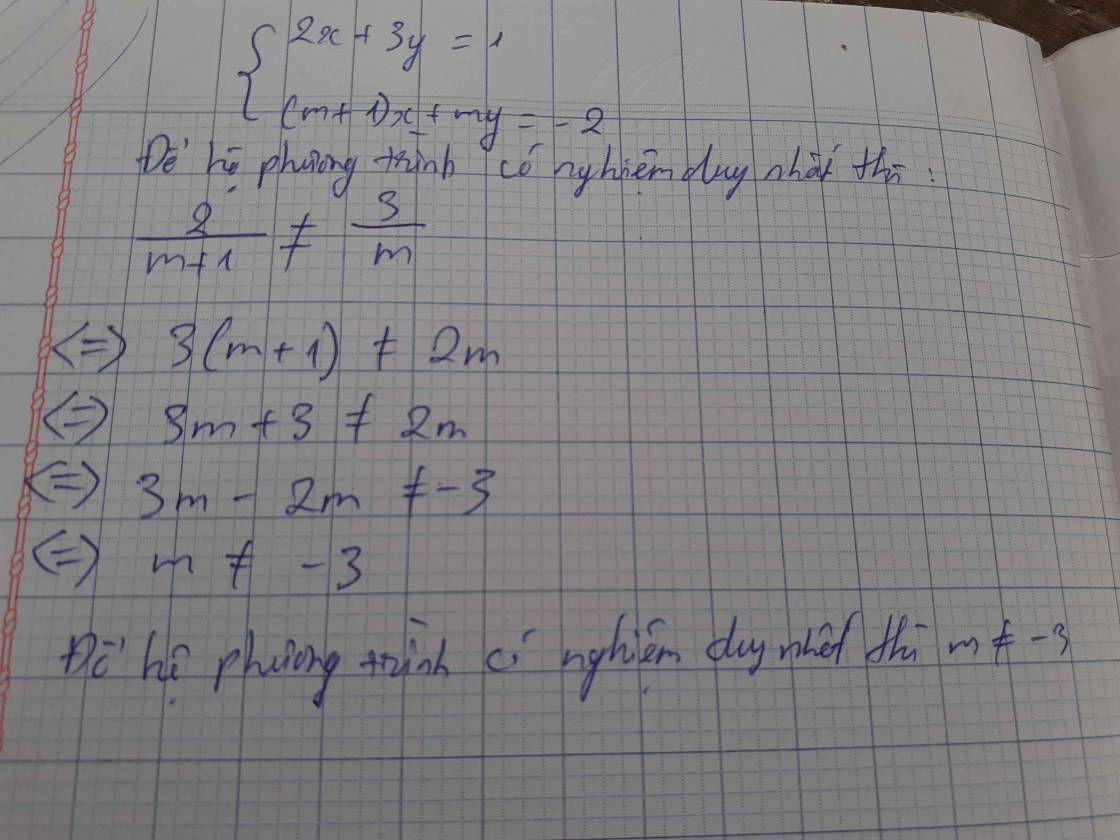

Hãy nhập câu hỏi của bạn vào đây, nếu là tài khoản VIP, bạn sẽ được ưu tiên trả lời.



`a,x-3y=2`
`<=>x=3y+2` ta thế vào phương trình trên:
`2(3y+2)+my=-5`
`<=>6y+4+my=-5`
`<=>y(m+6)=-9`
HPT có nghiệm duy nhất:
`<=>m+6 ne 0<=>m ne -6`
HPT vô số nghiệm
`<=>m+6=0,-6=0` vô lý `=>x in {cancel0}`
HPT vô nghiệm
`<=>m+6=0,-6 ne 0<=>m ne -6`
b,HPT có nghiệm duy nhất
`<=>m ne -6`(câu a)
`=>y=-9/(m+6)`
`<=>x=3y+2`
`<=>x=(-27+2m+12)/(m+6)`
`<=>x=(-15+2m)/(m+6)`
`x+2y=1`
`<=>(2m-15)/(m+6)+(-18)/(m+6)=1`
`<=>(2m-33)/(m+6)=1`
`2m-33=m+6`
`<=>m=39(TM)`
Vậy `m=39` thì HPT có nghiệm duy nhất `x+2y=1`
b)Ta có: \(\left\{{}\begin{matrix}2x+my=-5\\x-3y=2\end{matrix}\right.\)
\(\Leftrightarrow\left\{{}\begin{matrix}x=2+3y\\2\left(2+3y\right)+my=-5\end{matrix}\right.\Leftrightarrow\left\{{}\begin{matrix}x=2+3y\\6y+my+4=-5\end{matrix}\right.\)
\(\Leftrightarrow\left\{{}\begin{matrix}x=3y+2\\y\left(m+6\right)=-9\end{matrix}\right.\)
Khi \(m\ne6\) thì \(y=-\dfrac{9}{m+6}\)
\(\Leftrightarrow\left\{{}\begin{matrix}x=3y+2\\y=\dfrac{-9}{m+6}\end{matrix}\right.\Leftrightarrow\left\{{}\begin{matrix}x=3\cdot\dfrac{-9}{m+6}+2\\y=-\dfrac{9}{m+6}\end{matrix}\right.\)
\(\Leftrightarrow\left\{{}\begin{matrix}x=\dfrac{-27}{m+6}+\dfrac{2m+12}{m+6}=\dfrac{2m-15}{m+6}\\y=\dfrac{-9}{m+6}\end{matrix}\right.\)
Để hệ phương trình có nghiệm duy nhất thỏa mãn x+2y=1 thì \(\dfrac{2m-15}{m+6}+\dfrac{-18}{m+6}=1\)
\(\Leftrightarrow2m-33=m+6\)
\(\Leftrightarrow2m-m=6+33\)
hay m=39
Vậy: Khi m=39 thì hệ phương trình có nghiệm duy nhất thỏa mãn x+2y=1

mình giải tắt nhé vì mình không giỏi dùng công thức. Thông cảm nha.
1.
\(\left\{{}\begin{matrix}3x-y=2m+3\\x+y=3m+1\end{matrix}\right.\Leftrightarrow\left\{{}\begin{matrix}x=\dfrac{m}{4}+1\\y=\dfrac{-5m}{4}\end{matrix}\right.\)
vậy phương trình có nghiệm duy nhất là \(\left(\dfrac{m}{4}+1;\dfrac{-5m}{4}\right)\)
Thay vào đẳng thức ta được:
\(\left(\dfrac{m}{4}+1\right)^2+\left(\dfrac{-5m}{4}\right)^2=5\\ \Leftrightarrow x=\)

a: Khi m=căn 2 thì hệ sẽ là:
2x-y=căn 2+1 và x+y*căn 2=2
=>\(\left\{{}\begin{matrix}2x-y=\sqrt{2}+1\\2x+2y\sqrt{2}=4\end{matrix}\right.\Leftrightarrow\left\{{}\begin{matrix}-y-2y\sqrt{2}=\sqrt{2}-3\\2x-y=\sqrt{2}+1\end{matrix}\right.\)
=>\(\left\{{}\begin{matrix}y=-1+\sqrt{2}\\2x=\sqrt{2}+1+\sqrt{2}-1=2\sqrt{2}\end{matrix}\right.\Leftrightarrow\left\{{}\begin{matrix}x=\sqrt{2}\\y=\sqrt{2}-1\end{matrix}\right.\)
b: Để hệ có nghiệm thì 2/1<>-1/m
=>-1/m<>2
=>m<>-1/2

\( \left\{ \begin{array}{l} x + 2y = 1\\ 2x + 5 = - 4y \end{array} \right. \Leftrightarrow \left\{ \begin{array}{l} x + 2y = 1\\ 2x + 4y = - 5 \end{array} \right.\left( {VN} \right) \Rightarrow A\\ \left\{ \begin{array}{l} 2x - 3y = 5\\ 4x + my = 2 \end{array} \right. \Leftrightarrow \dfrac{2}{4} = \dfrac{{ - 3}}{m} \Leftrightarrow 2m = - 12 \Leftrightarrow m = - 6 \ne \dfrac{5}{2} \Rightarrow A \)

1.
a, \(\left\{{}\begin{matrix}2x-3y=3\\-4x=3x-13\end{matrix}\right.\Leftrightarrow\left\{{}\begin{matrix}2x-3y=3\\-4x-3x=13\end{matrix}\right.\)\(\left\{{}\begin{matrix}-4x+6y=-6\\-4x-3y=13\end{matrix}\right.\Leftrightarrow\left\{{}\begin{matrix}9y=-19\\-4x+6y=-6\end{matrix}\right.\)\(\Leftrightarrow\left\{{}\begin{matrix}x=-\dfrac{5}{3}\\y=-\dfrac{19}{9}\end{matrix}\right.\)
b, \(\left\{{}\begin{matrix}\dfrac{1}{x}+\dfrac{1}{y}=3\\\dfrac{3}{x}+\dfrac{2}{y}=7\end{matrix}\right.\Leftrightarrow\left\{{}\begin{matrix}\dfrac{3}{x}+\dfrac{3}{y}=9\\\dfrac{3}{x}+\dfrac{2}{y}=7\end{matrix}\right.\)\(\Leftrightarrow\left\{{}\begin{matrix}\dfrac{1}{y}=2\\\dfrac{3}{x}+\dfrac{3}{y}=9\end{matrix}\right.\Leftrightarrow\left\{{}\begin{matrix}x=1\left(TM\right)\\y=\dfrac{1}{2}\left(TM\right)\end{matrix}\right.\)
c, \(\left\{{}\begin{matrix}\dfrac{3}{x}-\dfrac{5}{y}=1\\\dfrac{2}{x}+\dfrac{1}{y}=3\end{matrix}\right.\left(x,y\ne0\right)\Leftrightarrow\left\{{}\begin{matrix}\dfrac{3}{x}-\dfrac{5}{y}=1\\\dfrac{10}{x}+\dfrac{5}{y}=15\end{matrix}\right.\)
\(\Leftrightarrow\left\{{}\begin{matrix}\dfrac{13}{x}=16\\\dfrac{10}{x}+\dfrac{5}{y}=15\end{matrix}\right.\Leftrightarrow\left\{{}\begin{matrix}x=\dfrac{13}{16}\left(TM\right)\\y=\dfrac{13}{7}\left(TM\right)\end{matrix}\right.\)
d, \(\left\{{}\begin{matrix}\sqrt{x+1}-3\sqrt{y-1}=-4\\2\sqrt{x+1}-\sqrt{y-1}=2\end{matrix}\right.\left(x\ge-1,y\ge1\right)\)
\(\Leftrightarrow\left\{{}\begin{matrix}2\sqrt{x+1}-6\sqrt{y-1}=-8\\2\sqrt{x+1}-\sqrt{y-1}=2\end{matrix}\right.\)\(\Leftrightarrow\left\{{}\begin{matrix}-5\sqrt{y-1}=-10\\2\sqrt{x+1}-6\sqrt{y-1}=2\end{matrix}\right.\)\(\Leftrightarrow\left\{{}\begin{matrix}\sqrt{y-1}=2\\2\sqrt{x+1}-6\sqrt{y-1}=2\end{matrix}\right.\Leftrightarrow\left\{{}\begin{matrix}x=3\left(TM\right)\\y=5\left(TM\right)\end{matrix}\right.\)

Để hệ phương trình có nghiệm duy nhất thì \(\dfrac{1}{m}\ne\dfrac{m}{1}\)
=>\(m^2\ne1\)
=>\(m\notin\left\{1;-1\right\}\)
Khi \(m\notin\left\{1;-1\right\}\) thì \(\left\{{}\begin{matrix}x+my=m+1\\mx+y=2m\end{matrix}\right.\)
=>\(\left\{{}\begin{matrix}x=m+1-my\\m\left(m+1-my\right)+y=2m\end{matrix}\right.\)
=>\(\left\{{}\begin{matrix}x=m+1-my\\m^2+m-m^2y+y-2m=0\end{matrix}\right.\)
=>\(\left\{{}\begin{matrix}y\left(-m^2+1\right)=-m^2+m\\x=m+1-my\end{matrix}\right.\)
=>\(\left\{{}\begin{matrix}y=\dfrac{m^2-m}{m^2-1}=\dfrac{m\left(m-1\right)}{\left(m-1\right)\left(m+1\right)}=\dfrac{m}{m+1}\\x=m+1-\dfrac{m^2}{m+1}\end{matrix}\right.\)
=>\(\left\{{}\begin{matrix}y=\dfrac{m}{m+1}\\x=\dfrac{\left(m+1\right)^2-m^2}{m+1}=\dfrac{2m+1}{m+1}\end{matrix}\right.\)
Để \(\left\{{}\begin{matrix}x>=2\\y>=1\end{matrix}\right.\) thì \(\left\{{}\begin{matrix}\dfrac{2m+1}{m+1}>=2\\\dfrac{m}{m+1}>=1\end{matrix}\right.\)
=>\(\left\{{}\begin{matrix}\dfrac{2m+1-2\left(m+1\right)}{m+1}>=0\\\dfrac{m-m-1}{m+1}>=0\end{matrix}\right.\)
=>\(\left\{{}\begin{matrix}\dfrac{2m+1-2m-2}{m+1}>=0\\\dfrac{-1}{m+1}>=0\end{matrix}\right.\)
=>\(\left\{{}\begin{matrix}-\dfrac{1}{m+1}>=0\\-\dfrac{1}{m+1}>=0\end{matrix}\right.\Leftrightarrow m+1< 0\)
=>m<-1